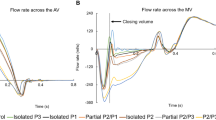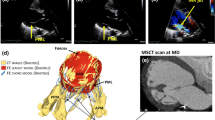Abstract
Mitral valve (MV) edge-to-edge repair (ETER) changes MV geometry by approximation of MV leaflets, and impacts left ventricle (LV) filling fluid mechanics. The purpose of this study was to investigate LV vortex with MV ETER during diastole. A computational MV–LV model was developed with MV ETER at the central free edges of the anterior and posterior leaflets. It was supposed that LV would elongate apically during diastole. The elongation deformation was controlled by the intraventricular flow rate. MV leaflets were modeled as a semi-prolate sphere with two symmetrical circular orifices and fixed at the maximum valve opening. MV chordae were neglected. FLUENT was used to simulate blood flow through the MV and in the LV. MV ETER generated two jets deflected laterally toward the LV wall in rapid LV filling. The jets impinged the LV wall obliquely and moved apically along the LV wall. Jet energy was primarily lost near the impingement. The jet from each MV orifice was surrounded by a vortex ring. The two vortex rings dissipated at the end of diastole. The total energy loss increased inversely with the MV orifice area. The atrio-ventricular pressure gradient was adverse near the end of diastole and possibly in diastasis. Reduction of the total orifice area led to more increment in the transmitral pressure drop than in the transmitral velocity. In conclusion, during diastole, two deflected jets from the MV under ETER impinged the LV wall. Major energy loss occurred around the jet impingement. Two vortex rings dissipated at the end of diastole with little storage of inflow energy for blood ejection in the following process of systole. MV ETER increased energy loss and lowered LV filling efficiency. The maintaining of a larger orifice area after ETER might not significantly increase energy loss in the LV during diastole and the transmitral pressure drop. The adverse pressure gradient from the atrium to the LV might be the mechanism of MV closure in the late diastole.







Similar content being viewed by others
References
Alfieri, O., F. Maisano, M. De Bonis, P. L. Stefano, L. Torracca, M. Oppizzi, et al. The double-orifice technique in mitral valve repair: a simple solution for complex problems. J. Thorac. Cardiovasc. Surg. 122(4):674–681, 2001.
Avanzini, A. A computational procedure for prediction of structural effects of edge-to-edge repair on mitral valve. J. Biomech. Eng. 130(3):031015, 2008.
Bellhouse, B. J. Fluid mechanics of a model mitral valve and left ventricle. Cardiovasc. Res. 6(2):199–210, 1972.
Claessens, T. E., J. De Sutter, D. Vanhercke, P. Segers, and P. R. Verdonck. New echocardiographic applications for assessing global left ventricular diastolic function. Ultrasound Med. Biol. 33(6):823–841, 2007.
Domenichini, F., G. Querzoli, A. Cenedese, and G. Pedrizzetti. Combined experimental and numerical analysis of the flow structure into the left ventricle. J. Biomech. 40(9):1988–1994, 2007.
Faludi, R., M. Szulik, J. D’Hooge, P. Herijgers, F. Rademakers, G. Pedrizzetti, et al. Left ventricular flow patterns in healthy subjects and patients with prosthetic mitral valves: an in vivo study using echocardiographic particle image velocimetry. J. Thorac. Cardiovasc. Surg. 139(6):1501–1510, 2010.
Fucci, C., L. Sandrelli, A. Pardini, L. Torracca, M. Ferrari, and O. Alfieri. Improved results with mitral valve repair using new surgical techniques. Eur. J. Cardiothorac. Surg. 9(11):621–626, 1995; discuss 6–7.
Gharib, M., E. Rambod, A. Kheradvar, D. J. Sahn, and J. O. Dabiri. Optimal vortex formation as an index of cardiac health. Proc. Natl Acad. Sci. USA 103(16):6305–6308, 2006; PMCID: 1458873.
Gharib, M., E. Rambod, and K. Shariff. A universal time scale for vortex ring formation. J. Fluid Mech. 360:121–140, 1998.
Hong, G. R., G. Pedrizzetti, G. Tonti, P. Li, Z. Wei, J. K. Kim, et al. Characterization and quantification of vortex flow in the human left ventricle by contrast echocardiography using vector particle image velocimetry. JACC Cardiovasc. Imaging 1(6):705–717, 2008.
Jeong, J., and F. Hussain. On the identification of a vortex. J. Fluid Mech. 285:69–94, 1995.
Kheradvar, A., M. Milano, and M. Gharib. Correlation between vortex ring formation and mitral annulus dynamics during ventricular rapid filling. ASAIO J. 53(1):8–16, 2007.
Kilner, P. J., G. Z. Yang, A. J. Wilkes, R. H. Mohiaddin, D. N. Firmin, and M. H. Yacoub. Asymmetric redirection of flow through the heart. Nature 404(6779):759–761, 2000.
Kim, W. Y., P. G. Walker, E. M. Pedersen, J. K. Poulsen, S. Oyre, K. Houlind, et al. Left ventricular blood flow patterns in normal subjects: a quantitative analysis by three-dimensional magnetic resonance velocity mapping. J. Am. Coll. Cardiol. 26(1):224–238, 1995.
Kolar, V. Vortex identification: new requirements and limitations. Int. J. Heat Fluid Flow 28(4):638–652, 2007.
Kunzelman, K. S., R. P. Cochran, E. D. Verrier, and R. C. Eberhart. Anatomic basis for mitral valve modelling. J. Heart Valve Dis. 3(5):491–496, 1994.
Maisano, F., A. Redaelli, G. Pennati, R. Fumero, L. Torracca, and O. Alfieri. The hemodynamic effects of double-orifice valve repair for mitral regurgitation: a 3D computational model. Eur. J. Cardiothorac. Surg. 15(4):419–425, 1999.
Pedrizzetti, G., and F. Domenichini. Nature optimizes the swirling flow in the human left ventricle. Phys. Rev. Lett. 95(10):108101, 2005.
Pedrizzetti, G., F. Domenichini, and G. Tonti. On the left ventricular vortex reversal after mitral valve replacement. Ann. Biomed. Eng. 38(3):769–773, 2010.
Pierrakos, O., and P. P. Vlachos. The effect of vortex formation on left ventricular filling and mitral valve efficiency. J. Biomech. Eng. 128(4):527–539, 2006.
Pierrakos, O., P. P. Vlachos, and D. P. Telionis. Time-resolved DPIV analysis of vortex dynamics in a left ventricular model through bileaflet mechanical and porcine heart valve prostheses. J. Biomech. Eng. 126(6):714–726, 2004.
Redaelli, A., G. Guadagni, R. Fumero, F. Maisano, and O. Alfieri. A computational study of the hemodynamics after “edge-to-edge” mitral valve repair. J. Biomech. Eng. 123(6):565–570, 2001.
Reul, H., N. Talukder, and E. W. Muller. Fluid mechanics of the natural mitral valve. J. Biomech. 14(5):361–372, 1981.
Schenkel, T., M. Malve, M. Reik, M. Markl, B. Jung, and H. Oertel. MRI-based CFD analysis of flow in a human left ventricle: methodology and application to a healthy heart. Ann. Biomed. Eng. 37(3):503–515, 2009.
Shi, L., and Z. He. Hemodynamics of the mitral valve under edge-to-edge repair: an in vitro steady flow study. J. Biomech. Eng. 131(5):051010, 2009.
Stoylen, A., S. Slordahl, G. K. Skjelvan, A. Heimdal, and T. Skjaerpe. Strain rate imaging in normal and reduced diastolic function: comparison with pulsed Doppler tissue imaging of the mitral annulus. J. Am. Soc. Echocardiogr. 14(4):264–274, 2001.
Vigmond, E. J., C. Clements, D. M. McQueen, and C. S. Peskin. Effect of bundle branch block on cardiac output: a whole heart simulation study. Prog. Biophys. Mol. Biol. 97(2–3):520–542, 2008.
Xiong, F., J. H. Yeo, C. K. Chong, Y. L. Chua, K. H. Lim, E. T. Ooi, et al. Transection of anterior mitral basal stay chords alters left ventricular outflow dynamics and wall shear stress. J. Heart Valve Dis. 17(1):54–61, 2008; discussion.
Yang, G. Z., R. H. Mohiaddin, P. J. Kilner, and D. N. Firmin. Vortical flow feature recognition: a topological study of in vivo flow patterns using MR velocity mapping. J. Comput. Assist. Tomogr. 22(4):577–586, 1998.
Acknowledgments
The study was supported by a grant of Beginning-Grant-in-Aid from the American Heart Association, South Central Affiliate (Grant No. 0665055Y), and by an Exploratory/Developmental Research Grant Award from the National Heart, Lung, and Blood Institute (Grant No. R21HL102526).
Author information
Authors and Affiliations
Corresponding author
Additional information
Associate Editor Karyn Kunzelman oversaw the review of this article.
Rights and permissions
About this article
Cite this article
Hu, Y., Shi, L., Parameswaran, S. et al. Left Ventricular Vortex Under Mitral Valve Edge-to-Edge Repair. Cardiovasc Eng Tech 1, 235–243 (2010). https://doi.org/10.1007/s13239-010-0022-6
Received:
Accepted:
Published:
Issue Date:
DOI: https://doi.org/10.1007/s13239-010-0022-6




